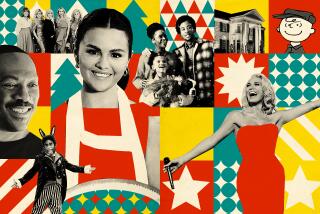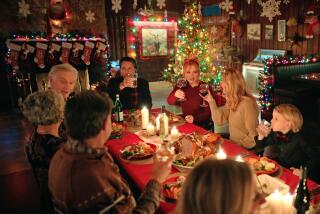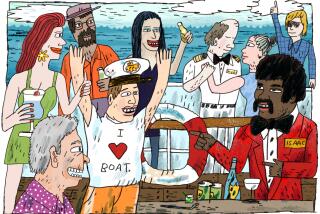Germany’s seasonal glow
Frankfurt, Germany — All I ever want for Christmas is a flash of that intense openhearted joy that sometimes comes during the holidays. But the Christmas spirit is elusive. To catch it, you have to be in the right place at the right time. So this year I went river cruising in Germany.
After all, it’s the country that gave us Christmas trees. With its mighty medieval cathedrals, painted Adorations and Annunciations, snug cobblestone hamlets and half-timbered houses, Germany looks like an Advent calendar all year long.
Yuletide celebrations begin in early December, when Christmas markets take over the main squares of almost every village and town. With them come craft, ornament and gift stalls decorated in silver garlands and lights. There are child-dazzling merry-go-rounds and miniature trains, life-size crèches, carriage rides, costumed St. Nicks, Handel’s “Messiah” and oom-pah bands, laughter, carousing, bratwurst and hot mulled Glühwein, Germany’s traditional Christmas market brew.
Christmas markets are as common in Germany as Fourth of July fireworks in America. But to make things easy, I booked a seven-night German Christmas market cruise on the Rhine and Main rivers from Encino-based Uniworld. The company specializes in European river cruising, a hassle-free way of sightseeing that Americans are just catching on to. It recently announced such itineraries as the Danube River from Budapest to the Black Sea and added two new ships, scheduled to join the fleet next year.
As on big cruise ships, the price includes meals, accommodations and many activities. Uniworld’s river vessels are smaller, more casual and more intimate than oceangoing megaships; the price is more modest; cabins and bathrooms have the same hair dryers, TVs and safes, but are larger; and there are some practical additional amenities such as laundry rooms. English is spoken by crew members and tour guides, and the ships usually dock just a few blocks from the heart of town.
My cruise on the year-old River Princess was designed to please inveterate Christmas shoppers as well as sightseers interested in German history and art. It was to start in Cologne, head up the fabled Rhine, turn east on the Main and the Main-Danube Canal and end in Nuremberg. Along the way, there would be bus trips to popular tourist destinations such as Heidelberg and, of course, Christmas markets wherever we stopped.
It was cold and rainy when I arrived early in the month at Frankfurt airport, hardly beginning to look a lot like Christmas. Cruise passengers connecting to a Cologne flight recognized one another because most of us carried the red vinyl bags Uniworld had sent with our travel documents. Some were already discussing Steiff teddy bears and Hummel figurines. One fellow Uni-world traveler told me she was such a Christmas buff that she had to have two trees in her house for all her ornaments.
When we disembarked in Cologne, a German woman I’d talked to on the plane advised, “Don’t drink too much Glühwein. Don’t spend too much.”
A boatload of shoppers
A bus transferred me and my tour companions to the ship, which was docked on the Rhine close to the cathedral of Cologne. The city, Catholic in the homeland of the Reformation, was rebuilt in the wake of World War II bombing and is thus now largely modern. No tour was planned there.
I soon discovered that most of the passengers were experienced travelers who never complained about jet lag, had booked tour extensions in Vienna or Prague and definitely didn’t need to have their hands held. Right away people set off to explore Cologne on their own, with maps or just the heaven-bent spires of the cathedral as guides.
The Dom, as it’s called, was begun in the Gothic 13th century and finished in the neo-Gothic 19th. It is all gables, turrets and flying buttresses, so massive that it seems out of scale with the rest of the city and prevalently dirty gray except in spots where it’s been recently cleaned.
A Christmas market, composed of wooden stalls with electric lights, occupied the square that borders the cathedral; another had encamped in a square several blocks south. I poked around in both, finding things I’d see later in other Christmas markets: costume jewelry, Christmas ornaments, figurines, mobiles, little ceramic half-timbered houses, candles, soaps, Polish teapots, African baskets, mittens and hats, earmuffs that light up. It was all more endearing than the stuff in malls, but nothing I needed.
The food was another story: fat, greasy bratwurst, stewed mushrooms, pretty cookies, Christmas fruit stollen, sizzling potato pancakes called Kartoffelpuffer with applesauce garnish. And Glühwein. Every town has a slightly different recipe and serves the drink in its own signature mug (which you can keep or give back for a return of your deposit). The red wine-based brew is warming but none too subtle; it reminded me of something I drank too much of at a mixer in college.
Slightly buzzed, I visited the Wallraf Richartz Museum, Cologne’s chief repository of medieval art. There, a Madonna painted about 1400 reminded me of a young Jodie Foster, and hell in Stefan Lochner’s whimsical 15th century “Last Judgment” looked like more fun than heaven.
I went back to the River Princess for the evening meal in the dining room at the stern of the ship, which has fabulous wraparound windows, red banquettes and starched napkins. The food came in three courses, with several choices for each.
That first night, I had a salad, veal steak and cheese plate; another night, it was fish soup, roast duck and eclairs. Everything looked better than it tasted, and the service was slipshod and rushed. You had to refill your own water glass and decide on your dessert at the beginning of the meal. No one, it seemed, minded too much, because in other respects the cruise was a good value for the price, chiefly because of the ship’s amenities. The River Princess is attractive and new, with a handsome lounge and piano bar up front, a mid-section patio where coffee and cookies were always available, and a roof deck and solarium for sun seekers and shutterbugs. The ship also has a tiny health club, with a sauna and four workout machines.
However, the cabins are the best thing about the River Princess, large enough for two, with showers designed so you don’t bruise your knees and elbows when you move. All the cabins are the same size and decorated in a smart minimalist style. But the window sizes are proportional to the price of the chamber, with floor-to-ceiling windows on the top deck, waist-to-ceiling windows in the middle and shoulder-level windows just above river level on the bottom. The beds have European duvets and are comfy nests at night as the ship cruises smoothly through inland waterways. That’s where I was the next morning when the Australian cruise director, David Singleman, announced over the P.A. system that we were entering the most scenic part of the Rhine River. So I ran up to the top deck, where the sun was coming out for the first and only time during the trip, to find the River Princess passing ruined castles on cliffs near the towns of St. Goar and St.Goarshausen. At this point the Rhine narrows dramatically and turns past Lorelei Rock, where, according to German legend, a crooning maiden lures sailors to their death.
We spent the day docked in the hamlet of Rüdesheim, where the north-south-flowing Rhine turns abruptly east, producing a warm microclimate conducive to grape-growing. There we had a group tour of Siegfried’s Mechanical Musical Instrument Museum, with its whimsical antique player pianos and music boxes, and then we were let loose on the town’s bustling Christmas market.
Right away I had some Glühwein,which has a slightly pruney taste in Rüdesheim, bought a pretty blue bottle of plum brandy at a booth and was charmed by three teenage girls in Santa hats who couldn’t restrain themselves from singing “Jingle Bells” (in English) as they strolled through the market.
When the stalls on High Street petered out, I found a wine shop where I tasted at least a dozen Rieslings, priced between $6 and $10 a bottle, before buying an assortment of six. (Later, at an efficient German post office, I sent the box -- for about $25 -- to relatives in Brussels. It reached them, undamaged, in a matter of days.)
River Princess passengers reconnoitered that night for a specially arranged dinner at a local inn. The owner and his wife plied us with a delightful Riesling from the family vineyard while we showed each other the treasures we’d bought at the market. Most were Christmas bric-a-brac, but a man from Cleveland who collected Steiff bears had found one from a limited edition. It cost him about $100, and it was wearing a Rüdesheim medallion around its furry neck as if it were the town mayor.
The next morning, docked in Mainz, about 20 miles downriver, we prepared for a half-day bus trip to the romantic university town of Heidelberg. There a local guide took us through the ruined castle above town and pointed out the home of Steffi Graf and Andre Agassi on the far side of the Neckar River. But Heidelberg didn’t seem to look its best in gray winter weather, and the Christmas market there was disappointingly small.
Back at the ship, we learned we couldn’t get on the Main River because the water was too high for the River Princess to pass under low bridges. Later, I discovered this happens occasionally on German river cruises, notably last summer when two Uniworld ships headed in opposite directions on the Danube were forced to stop at the same low bridge. Instead of turning around and retracing their routes, they exchanged passengers, who were thus able to carry on with their cruises as planned.
A change of plans
There was no such ingenious solution to our dilemma. Nevertheless, most passengers were understanding, even though we wouldn’t be able to get to Wertheim, Würzburg and Bamberg on the Main and Main-Danube Canal. The diversion also made our scheduled bus trips to the walled medieval town of Rothenburg and the city of Nuremberg longer than originally planned. They became grueling 10-hour affairs, with six hours spent on buses and barely enough time left to shop and tour. Still, in Rothenburg I walked the ramparts and bought ornaments at the Käthe Wohlfahrt store, part of a chain of German Christmas shops open year-round. I also visited the town’s Museum of Medieval Crime, which showcases such instruments of punishment as thumbscrews, racks, head trusses and chastity belts.
In Nuremberg, shopping briefly yielded to modern history as we drove past the parade ground where Hitler held massive Nazi party rallies. The once handsome old city was the spiritual heart of the Third Reich, so it was virtually leveled during World War II. Still, a small historic section remains, where the Christmas market was centered. It turned out to be one of the biggest and best we visited, great fun to roam and noted for its Christmas Lebkuchencookies.
Despite the long bus trips, the cruise diversion had compensations, beginning with an unscheduled overnight in the pretty Romanesque cathedral town of Speyer on the Rhine, south of Mainz. There I toured the museum, which had a special exhibit on toy trains and gangly-armed mohair Steiff bears. I ate a bratwurst that was so long it stuck several inches out of its round bun, drank Glühweinand then started some serious shopping. I’d come with a list of German products that are expensive in the U.S., like FinnComfort shoes (about $200 here) and Dr. Hauschka skin cream (about $20 per ounce at my L.A. beauty supply store). In shops along Speyer’s pleasant main street I found both for half the U.S. price.
On the last day of the cruise we managed to get on the Main River, but only as far as Frankfurt, which also had a Christmas market, of course.
But I spent my happiest hours there at an evening concert in a Carmelite church that now houses the city’s archeological museum. The program featured Elizabethan choral works sung by a small choir, their voices echoing into the building’s lofty rafters.
When they got to William Byrd’s “Teach Me, O Lord,” a hot current ran up my spine and lodged someplace in the vicinity of my heart. It wasn’t the aftereffect of the Glühwein I’d had at the market. It was the Christmas spirit, which, when you finally get it, is just as transporting in Germany as it is at home.
More to Read
Sign up for The Wild
We’ll help you find the best places to hike, bike and run, as well as the perfect silent spots for meditation and yoga.
You may occasionally receive promotional content from the Los Angeles Times.






